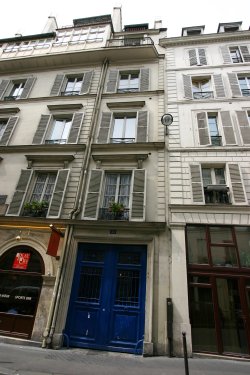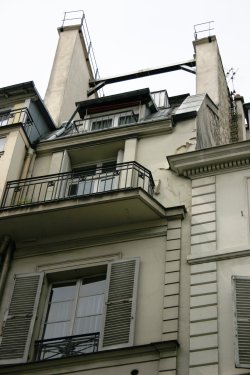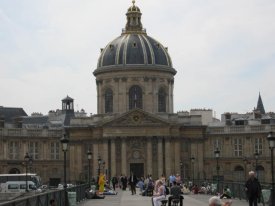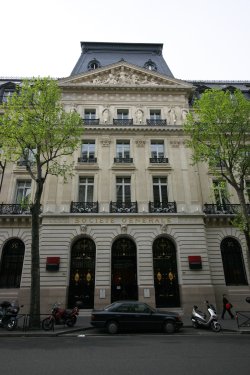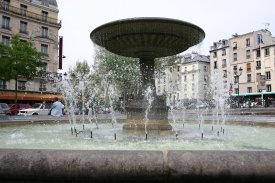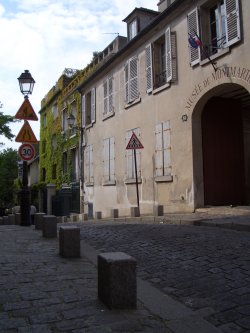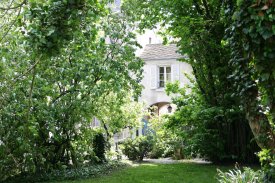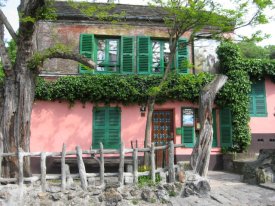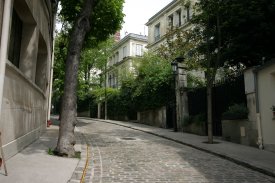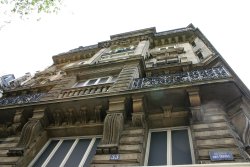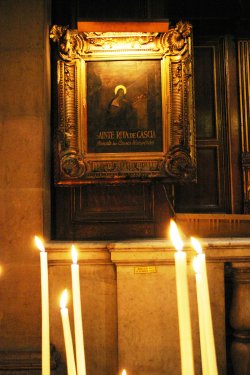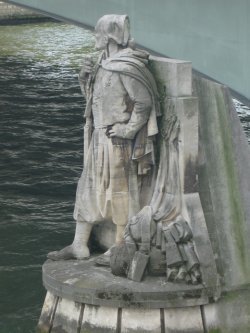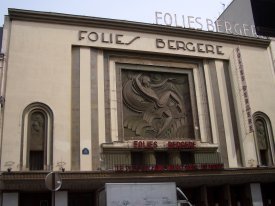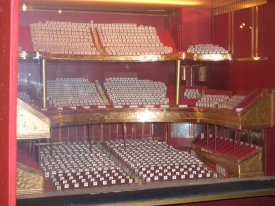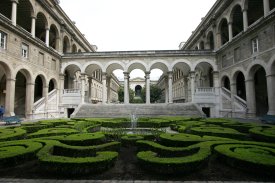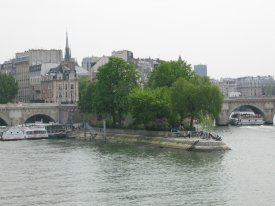Renoir and Friends in Paris
|
|
|
|
In 1880, the time of the novel, Renoir lived at 35 rue St. Georges in the Ninth Arrondissement, just south of Montmartre. Though this building was damaged in World War II bombing, it was rebuilt nearly as it was before. Just across the street was Camille's Crémerie where he had his meals. |
|
Artists' studios were on the top floor, with a bank of windows for light which was uncommon in other apartments in the 19th century. We can assume his was at the very top. |
|
Crossing the river on the Passerelle des Arts, Auguste was seized by a thought. He was straddling more than just the Seine. The iron and wood footbridge stretched from the Louvre on the Right Bank to the formidable, gold-ribbed dome of the Institut de France housing the Académie des Beaux-Arts on the Left Bank. The new art was a Right Bank school growing out of ragtag Montmartre and the suburban riverside to the west, as far from the classical, tradition-bound Left Bank Académie as it could get. Yet the painting that swirled in his mind, even though modern in subject, required the skill of the classicists. He felt as giddy as he had as a youth the moment before touching the first breast offered to him. |
|
Auguste dropped off the supplies at his studio and walked the half dozen blocks to Gustave's apartment on boulevard Haussmann. Lined with elegant cafés and smart shops, the boulevard was clearly a different neighborhood than his own. He entered beneath the gilt ironwork, went up two flights, and pulled the bell cord. Piano music stopped. Gustave's brother, a composer, let him in. "He's painting on the balcony," Martial said. |
|
Fountain at place Pigalle. Place Pigalle, dividing Montmartre from Paris proper, was and still is the center for nightlife, for rendezvous at the fountain, for a vibrant mix of high and low culture. She wasn't a raving beauty. Her face was a bit too chubby and her hair was thin and lifeless, but oh, her spirit. He remembered the sweltering summer day when she had jumped into the fountain of place Pigalle, fully dressed, and splashed him. Her zest would have been perfect for his new painting. She had done some good things with him, Cup of Chocolate, Lovers and Confidences, and Woman with a Cat. But the one good thing he could have done for her in return, he hadn't done. The one thing any responsible lover would have done. |
|
On the Butte, the summit of Montmartre, Renoir rented a room and studio in 1876 in order to work on Bal au Moulin de la Galette, painted at the rustic, open air dance hall a few blocks downhill. Here is his entrance to the shared domicile. Today, the building houses the Musée Montmartre, and displays some of the works painted in the area. An exquisite film describing the complexities and the spirit of Renoir's Moulin painting is shown there continuously. |
|
In this garden on the property, Renoir painted La Balançoire, The Swing, which hung from one of the large trees. Some art historians believe the model to be Margot Legrand, who jumped into the fountain at place Pigalle. |
|
Between Moulin de la Galette (now private and walled) and Renoir's studio on rue Cortot was Cabaret des Assassins on rue des Saules. This is where Auguste and Paul finally find Angèle in Chapter Six. The rustic cottage is much the same today only the name changed in the late 19th century to Le Lapin Agile. On the exterior side wall is a painting of an agile rabbit leaping out of a frying pan. Out of an opened door spilled music and yellow light onto the small hillside vineyard. Above it, he could just make out the trees in the garden where he had painted Margot standing on the swing. He listened. Canéla, a painter by day and a tenor by night, was singing the melancholy song from Offenbach's La Vie Parisienne about a man writing to a prostitute asking her to give his friend the same pleasure she had once given him. Just the kind of song Angèle would request. They ducked under the low doorframe. |
|
The actress Jeanne Samary lived on this street, as did Renoir's son Jean, the film director, some time later. Avenue Frochot, her little oasis of a street, a one-block crescent, calm and leafy. Not a monstrous block of apartments on a busy boulevard, nor the oddly shaped cottages of Montmartre, but an avenue secreted between the two, each maison particulière separate from each other and with a distinct character, her home since girlhood. She would hate so very much to leave it. She looped her hand around his arm and told him where the painter Eva Gonzales lived, and showed him Madame Galantière's iron bench where her life had taken a turn, Madame who was like an aunt to her and never missed her opening nights. She told him Victor Hugo had once lived at number five, and she described the grand day of her childhood when crowds followed him home when he returned to Paris after the Siege, and how he spoke to them from his balcony above the tier of arches, the great world coming to her little street. |
|
During the Siege of Paris, Alphonsine lived above her hat shop at 33 avenue des Ternes. |
|
The Offertory of Sainte Rita de Cascia is in the Church of the Madeleine. Amid the din of screams and moans, the nuns calling for more bandages, the stench of rotting flesh and feces, she squeezed her way past rows of wounded men on cots to get to the small painting and offertory of Sainte Rita, Advocate of Desperate Causes, and said the prayer. You, the saint of the impossible, give me the courage to hope. Tell me how to love more. She'd lit two candles. Neither one was for her. |
|
The Zouaves were Algerian soldiers who fought in the French army, fierce fighters put in the most dangerous situations. They are referred to three times in the book. |
|
Ellen Andrée was a mime in the Folies Bergère, still located on rue Richer near rue Saulnier, and still producing entertainments. |
|
This model at the ticket window is used for patrons to select seats. Onstage that night, her arms were fluid with feeling, her hands eloquent with love, her fingers alive with new witticisms. She wrenched applause from the grand horseshoe-shaped theater, took a deeper bow than usual, and descended the iron steps breathing hard, loving the Folies after all. |
|
Since the 12th century when l'Hôtel Dieu served medieval pilgrims traveling great distances, there has been a charity hospital adjacent to Notre Dame on Ile de la Cité. On the steps to the Hôtel Dieu, a woman more pitiful than Charlotte with a baby wrapped in her shawl held up her callused palm. Seeing the mother not even raising her eyes from the child gave her a stab of cold fear. "She sure picked a lousy place to beg," Ellen muttered. She couldn't understand why the woman hadn't stationed herself near the entrance to Notre Dame just adjacent. More likely offerings there. "Can we give her something?" Charlotte asked. Ellen dropped her a fifty-centime piece and took Charlotte inside to the cloistered garden and had her sit on a bench while she registered her with an elderly nun at the wicket, paid the donation fee, and gave Charlotte the remaining francs. |
|
Ellen walked to the point of Ile de la Cité from Hôtel Dieu and spoke to some old men fishing there. There was only so much summer. The end of August already. She could take a little time. She sauntered along the river, crossed the roadway of Pont Neuf, and descended to the leafy point of the island facing downstream like the prow of a ship. It was pleasant and cool with the river very close on three sides of her. |
